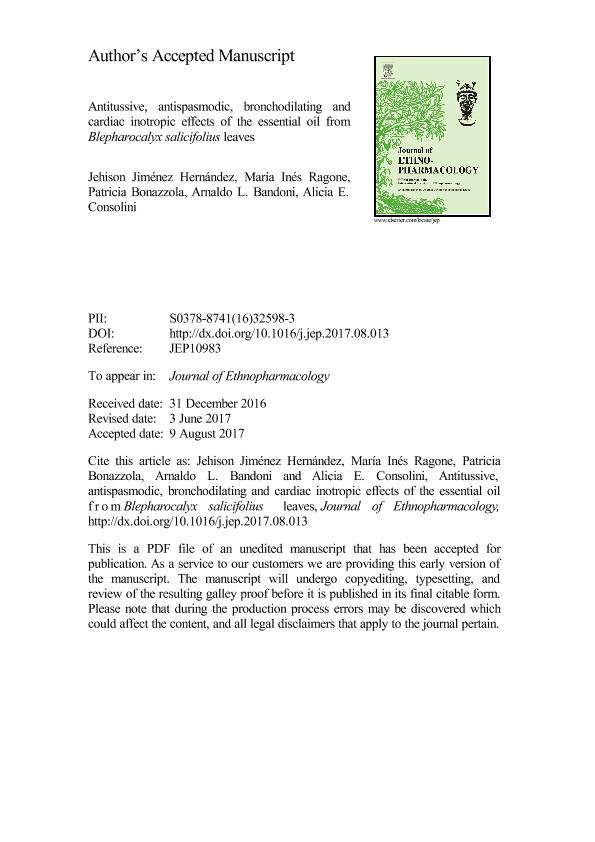Mostrar el registro sencillo del ítem
dc.contributor.author
Hernández, Jehison Jiménez
dc.contributor.author
Ragone, María Inés

dc.contributor.author
Bonazzola, Patricia

dc.contributor.author
Bandoni, Arnaldo Luis

dc.contributor.author
Consolini, Alicia Elvira

dc.date.available
2018-04-12T16:47:20Z
dc.date.issued
2018-01
dc.identifier.citation
Hernández, Jehison Jiménez; Ragone, María Inés; Bonazzola, Patricia; Bandoni, Arnaldo Luis; Consolini, Alicia Elvira; Antitussive, antispasmodic, bronchodilating and cardiac inotropic effects of the essential oil from Blepharocalyx salicifolius leaves; Elsevier Ireland; Journal of Ethnopharmacology; 210; 1-2018; 107-117
dc.identifier.issn
0378-8741
dc.identifier.uri
http://hdl.handle.net/11336/41850
dc.description.abstract
Ethnopharmacology relevance: Blepharocalyx salicifolius (Kunth) O. Berg (Myrtaceae) is a tree native to Argentina and Uruguay that grows and is cultivated along the riverside of the Rio de la Plata. The leaves of this plant species, locally known as “anacahuita” are used in South America to prepare infusions for the empiric treatment of cough and bronchospasm, as well as diarrhoea and other intestinal disorders. Although previous phytochemical studies have been performed with the essential oil extracted from Blepharocalyx salicifolius, pharmacological evidence supporting its traditional use is still lacking. Aim of the study: To experimentally evaluate the pharmacological properties of Blepharocalyx salicifolius based on its traditional use. The studies were performed with tincture (T-Bs) and essential oil (EO-Bs) prepared from its leaves, in isolated rat trachea, intestine and heart preparations. Methods: The ex-vivo effects of T-Bs and EO-Bs were evaluated with the agonists carbachol (CCh) and calcium chloride (Ca2+) in the contractile concentration-response curves (CRC) of the isolated intestine. The muscle relaxant effect of EO-Bs was evaluated in the isolated trachea and compared with the effect achieved with papaverine as a positive control. The T-Bs and EO-Bs cardiac effects were analysed by perfusion of an isolated rat heart before a period of ischemia/reperfusion (stunning model). The antitussive effect of both T-Bs and EO-Bs was evaluated in mice exposed to ammonia using codeine as a positive control. Results: Both T-Bs and EO-Bs induced a non-competitive inhibition of the CCh-CRC in the rat intestine, with IC50 values of 170.3 ± 48.5 µg T-Bs/mL (n = 6) and 5.9 ± 1.6 µg EO-Bs/mL (n = 6), respectively. EO-Bs also inhibited non-competitively the Ca2+-CRC, with IC50 value of 1.8 ± 0.3 µg EO-Bs/mL (n = 8). A similar effect was obtained with the main active component of the EO-Bs 1,8-cineole. In isolated trachea, EO-Bs induced the relaxation of the CCh-contracted tissue (1.7 ± 0.2 µg EO-Bs/mL, n = 11) up to a maximal relaxation that was 1.9 times higher than that of papaverine. In the isolated heart, EO-Bs induced a poor negative inotropic response, and did not improve the contractile and energetic recovery after ischemia and reperfusion. In the mouse cough model, EO-Bs (90 mg/Kg) was as effective as codeine (30 mg/Kg) in reducing cough frequency. Conclusions: The results indicate that the preparations from Blepharocalyx salicifolius leaves were effective as central antitussive, bronchodilating and antispasmodic agents, suggestive of a mechanism associated with the inhibition of Ca2+ influx into smooth muscle. The EO-Bs displayed only a poor ability to reduce cardiac inotropism, and was devoid of any cardioprotective properties. Thus, the present study validates the traditional use of this South American plant for asthma, cough and bronchospasm, shedding new light into its potency and putative mechanism of action.
dc.format
application/pdf
dc.language.iso
eng
dc.publisher
Elsevier Ireland

dc.rights
info:eu-repo/semantics/embargoedAccess
dc.rights.uri
https://creativecommons.org/licenses/by-nc-nd/2.5/ar/
dc.subject
Antispasmodic
dc.subject
Antitussive
dc.subject
Blepharocalyx Salicifolius
dc.subject
Bronchodilator
dc.subject
Essential Oil
dc.subject.classification
Otras Ciencias de la Salud

dc.subject.classification
Ciencias de la Salud

dc.subject.classification
CIENCIAS MÉDICAS Y DE LA SALUD

dc.title
Antitussive, antispasmodic, bronchodilating and cardiac inotropic effects of the essential oil from Blepharocalyx salicifolius leaves
dc.type
info:eu-repo/semantics/article
dc.type
info:ar-repo/semantics/artículo
dc.type
info:eu-repo/semantics/publishedVersion
dc.date.updated
2018-04-11T16:02:33Z
dc.journal.volume
210
dc.journal.pagination
107-117
dc.journal.pais
Irlanda

dc.description.fil
Fil: Hernández, Jehison Jiménez. Universidad Nacional de La Plata. Facultad de Ciencias Exactas. Departamento de Ciencias Biológicas; Argentina
dc.description.fil
Fil: Ragone, María Inés. Universidad Nacional de La Plata. Facultad de Ciencias Exactas. Departamento de Ciencias Biológicas; Argentina. Consejo Nacional de Investigaciones Científicas y Técnicas; Argentina
dc.description.fil
Fil: Bonazzola, Patricia. Consejo Nacional de Investigaciones Científicas y Técnicas. Oficina de Coordinación Administrativa Houssay. Instituto de Investigaciones Cardiológicas. Universidad de Buenos Aires. Facultad de Medicina. Instituto de Investigaciones Cardiológicas; Argentina
dc.description.fil
Fil: Bandoni, Arnaldo Luis. Universidad de Buenos Aires. Facultad de Farmacia y Bioquímica; Argentina
dc.description.fil
Fil: Consolini, Alicia Elvira. Universidad Nacional de La Plata. Facultad de Ciencias Exactas. Departamento de Ciencias Biológicas; Argentina
dc.journal.title
Journal of Ethnopharmacology

dc.rights.embargoDate
2018-08-01
dc.relation.alternativeid
info:eu-repo/semantics/altIdentifier/doi/http://dx.doi.org/10.1016/j.jep.2017.08.013
dc.relation.alternativeid
info:eu-repo/semantics/altIdentifier/url/https://www.sciencedirect.com/science/article/pii/S0378874116325983
Archivos asociados
